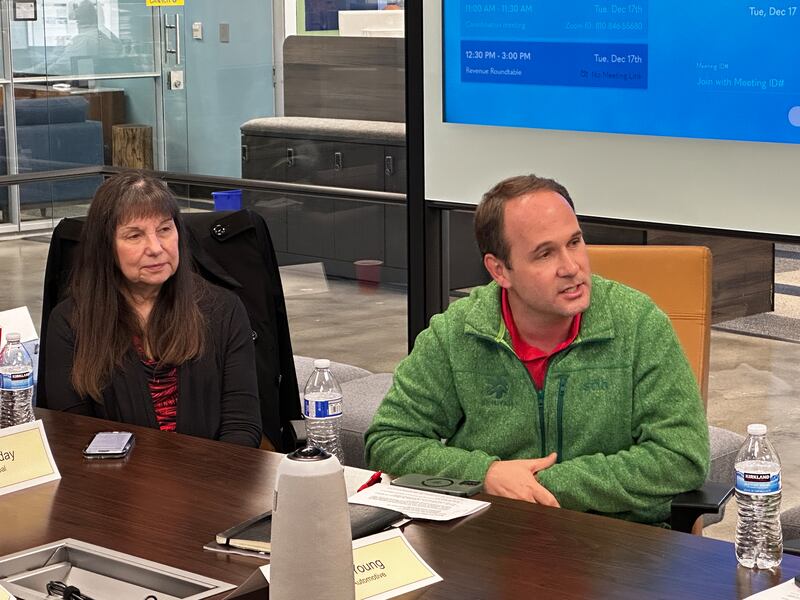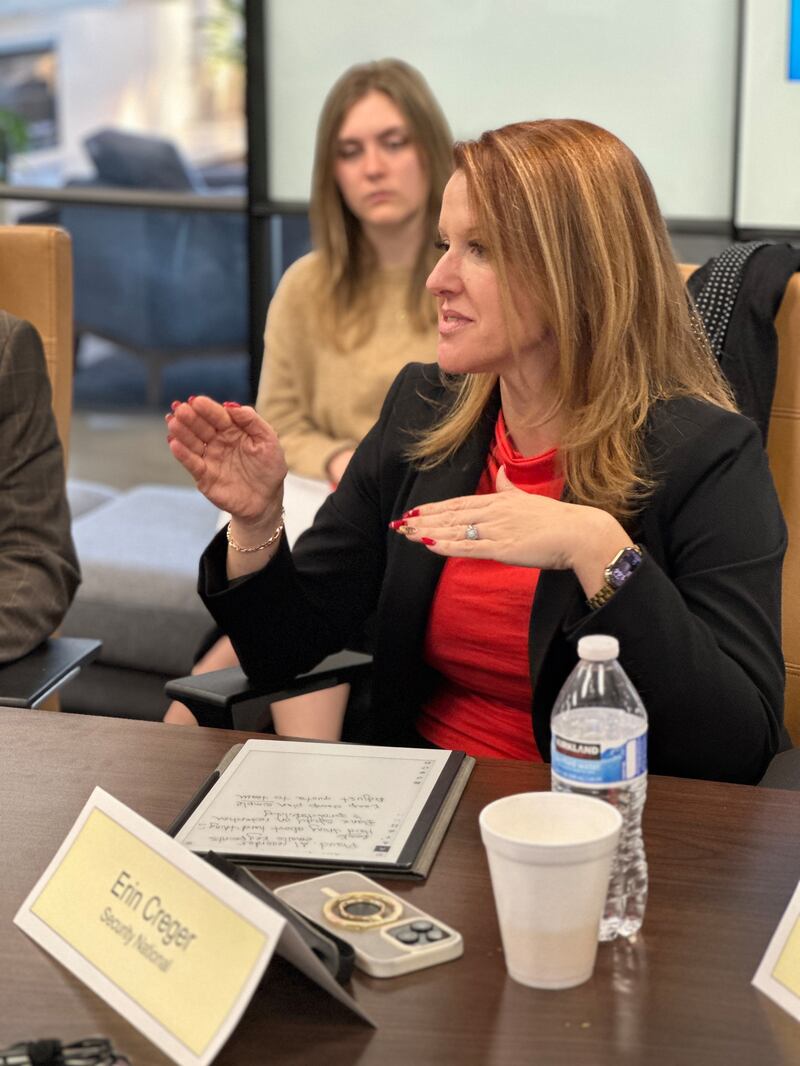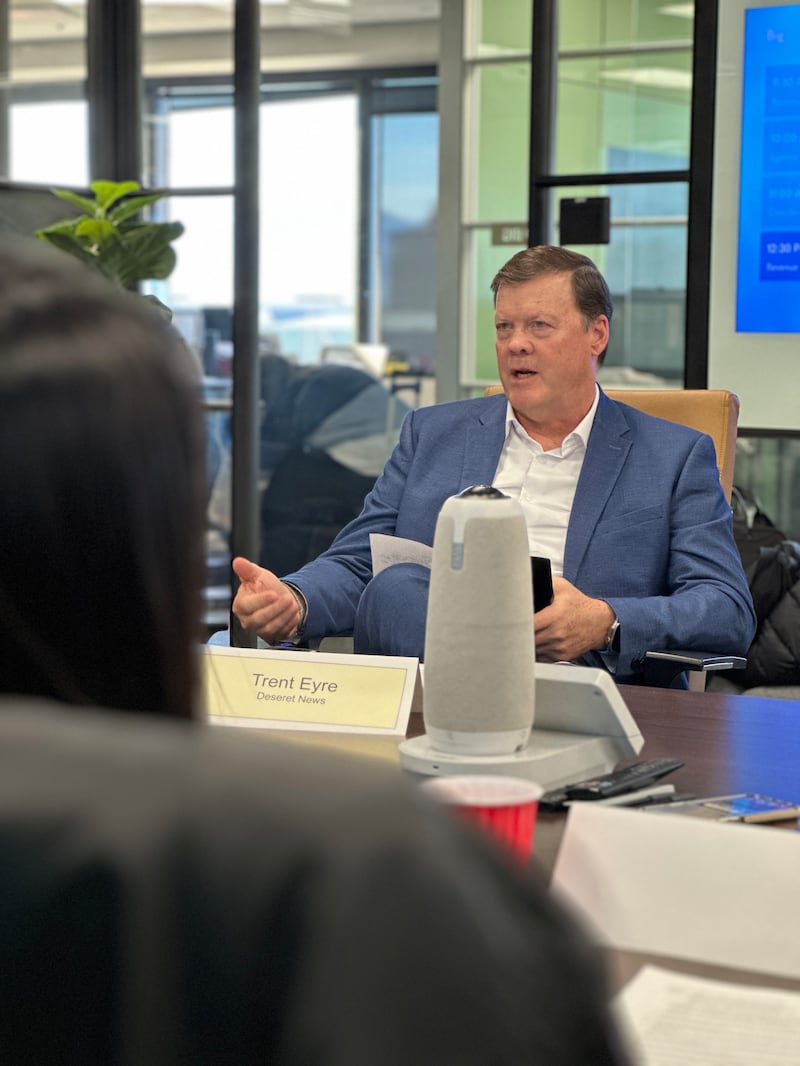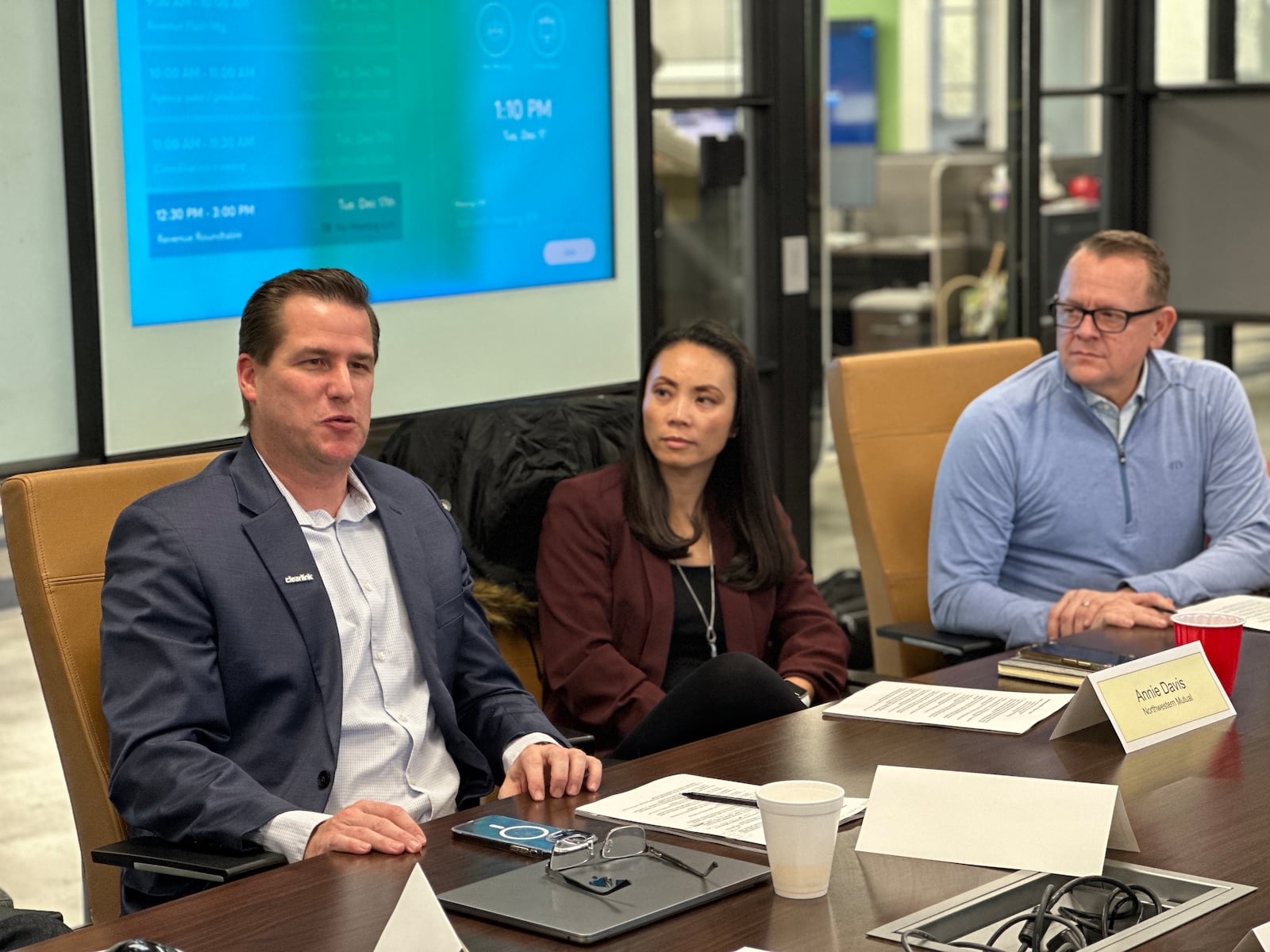This story appears in the 2025 issue of the Book of Lists. Purchase here.
Last month, Utah Business partnered with Fullcast to host a roundtable featuring Utah’s sales experts. This conversation was moderated by Annie Davis, CMO at Northwestern Mutual Utah.
What current trends are you paying particular attention to?
Lance Evanson | Co-Founder & CCO | Fullcast
We have an AI function within our platform. … I have yet to go through a security review, an IT compliance review or a contract where they are not asking in-depth questions about its capabilities, what we’re doing, and how we’re protecting and securing data. … We’re balancing the product development of our offerings with trying to figure out how we can make sure that we’re offering the right contract language and security.
Karin Maday | Chief Customer Success Officer | Jade Global
We help customers take AI and put it into their environment. We’re developing our own AI tools to accelerate implementation and maintain systems better. … One thing I’ve noticed from customers is they want to take advantage of the LLM models that are out there. They want information, but they don’t want to contribute to it. They want to firewall; they want to pull it in, stick it inside their firewall and use their own data along with it but firewall so that it never gets back out to the bigger model. I can totally understand, but if they want that model to grow and be more effective for them in the future, they also have to contribute to it.
Brian Brown | VP, Sales | Clearlink
We sell home security, internet, TV, wireless — all kinds of products — for Fortune 500 companies. We’re in the middle of that beta-testing legacy phase because we want to have the cost savings and be on the front end of the AI. … With highly consultative sales, like our B2B channels, we haven’t really delved in with AI. It’s just too difficult. But with our customer service and customer acquisition, where you need to lead the customer a little bit more, we like putting our toes in. What we’ve done well with some AI tools is with just general customer service. It’s being more widely accepted, at least from our angle. … We’ve had some failures and we’ve had some successes, but when you nail it right, the cost savings, revenue and profit are huge.

Are you seeing tools like customer relationship management or AI platforms leveraged to drive top line, or are you using these tools and platforms to help you streamline efficiencies and things to manage bottom line?
Todd Handy | Strategic Advisor | Audience
For me, it’s top-line growth. You can’t cut your way through success. You can’t cut your way to growth. If you are declining in your revenues, it doesn’t matter how great your margins are; sooner or later, you’re not going to get there. … Media companies are all struggling with that right now. They’re all about cutting the bottom line, but if you’re not growing the top line, it doesn’t matter. … If I can make my sellers much more efficient, that’s great. But I’m not about making them efficient so I can have fewer sellers. I’m about making them efficient so I can have more sellers so I can have greater revenue.
Oliver Young | COO | Young Automotive Group
We introduced some technology to get predictive sales. We have people coming through our service drives, we get data coming through, and a lot of our sellers would be looking at that predictive sales model. They got so entrenched in it that that’s all they talked to. But there were customers right there [in front of them]! Go talk to them. Sometimes, the sales models and data should be pushing you in a direction, but it shouldn’t take over your entire brain. … That human element, I think, is so crucial in sales. Technology can point us and move us in the right direction, but then you have to know what the next 10 steps are.
Jonathan Kantor | Chief Revenue & Marketing Officer | Gozney
In the past, we’ve built two or three consumer archetypes. This year, we adopted a new tool called Verve — AI agents that represent your consumer archetypes. … We’ve thought about AI as a way to get smarter in what we’re doing in the selling process and in marketing our products. With this tool, Verve, we built all these archetypes, and we say, “Archetype, Bob, do you like this product in blue or black?” And we get immediate feedback. … It’s been really empowering for product development, campaign building, sales and marketing.
Jed Beck | Chief Revenue Officer | Pattern
Sales coaching is a lot easier now that you have AI — you can be involved in way more conversations. Prior, if you were a leader of sales, you needed to go on periodically, sit on calls and listen. Now, you can get a lot of information and data just by using an AI like Gong or CoPilot.
For back-end, bottom-line management, there are really good tools now for churn risk. You can’t touch every customer if you have thousands of them, but you can know who’s potentially at risk. That can be run easily through AI and quickly flag people who need to be watched or monitored closely as you’re making sure that you keep your [gross revenue retention] GRR and [net revenue retention] NRR up. … If you don’t have those now, you’re probably behind, and your competitors are using them.

Technology is just one play in the playbook. What other strategies have you found effective when it comes to driving sales and revenue growth?
Trent Eyre | SVP, Advertising | Deseret News
One of the pivots we’ve tried to make and are making currently is moving away from product-based selling into solution-based selling. We’re solution people, but when you’re selling a product, it’s pretty hard to be objective and look at the needs of a client because all you’re trying to do is sell that product. We have approached that transition by launching a full-service ad agency within our company. We sell as many non-owned properties as we sell our own properties, but it allows us to sit down with the client and not start with the product, start with the client and come back with a solution that may or may not include properties we own. Ultimately, our goal is to come up with the right solution, which then helps with retention, credibility and trust.
Steve Stewart | Chief Sales Officer | Snap Finance
Make sure your salespeople understand how the compensation plan works. Go through that plan, design with them and ask them about their personal goal. Hopefully, it’s always above the assigned goals. … Then assess where they have gaps relative to peers or other people across the organization for areas to improve. … If you empower them to develop their own plan, … it translates into so many good things as far as just their willingness to dig in and understand how they can constantly improve.
Karin Maday | Chief Customer Success Officer | Jade Global
In B2B, everything is face-to-face with a customer trying to get them to buy something. One of the things we’re incorporating is a consultative mindset as you sell. You know the industry lingo, so you can talk to them about the right KPIs. You want to drive a solution — a full solution — for them, but you have to listen really carefully to what their goals are in a consultative way. When you do that, you’re bringing all those things together. In a B2B market, you get one chance, and if you blow it, then you don’t get another. If you get the first one, you still have to do it again and again and again to retain those people. … It does take a certain kind of salesperson. You can’t train everybody to do that, so you have to be very clear on what that sales role is.
Erin Creger | Chief Sales Officer | Security National Financial Corporation
We’re focusing more on the solution. We’re focusing much more on lead measures, getting away from the lag measures and making sure people understand that. They are advisors; they’re consultants. It’s not like it used to be at cemeteries, where a family comes in, and they have eight generations of legacy that they’re all going to be together. … We also have one shot. You’re not going to get someone to get up and get dressed, put on a tie, put on lipstick and drive to a cemetery more than once. We have to ask the right questions … so we can educate on the solution and get away from that product.

How are you motivating and aligning your sales teams to maximize their performance so you’re hitting those revenue and sales targets?
Craig Daly | Chief Revenue Officer | Nectar
Spiffs are a huge part of getting people to go for things. We started introducing things as crazy as … giving away Teslas. … That tends to move the needle to some wild extent. If somebody’s coming in for a 5K bump base because they hit a certain milestone, it doesn’t really move the needle. It doesn’t do a whole lot to the family. If you’re giving somebody a car — the perceived value is immense. … It might seem extreme to that financial controller, but those things seem to really bring the relationship there.
Curtis Call | Executive Sales Leader
I love this idea around spiffs. I think it’s a huge motivator. … One of the things we learned in that process was that if you offer up one car and say, “Hey, the best guy gets this.” About three months into that process, everybody else is going, “Ah, he’s way ahead. I can’t catch him.” They give up. We like the idea of do it and get it. Anyone who achieves a certain thing is going to get the Tesla. Whatever that item is, you keep everyone motivated and going for it. … You move an entire force better when you allow anyone to go get that reward.
Erin Creger | Chief Sales Officer | Security National Financial Corporation
There’s also new data around how quickly spiffs have to be given out. … Gift cards are done. You can give someone a hundred bucks cash or a $600 gift card; almost half the time, they’re not even going to use it. … Cash is king, but it has to be quick. We’re still trying to figure out exactly what that looks like as we scale.
Ben Fox | VP of Sales & Marketing | Alsco Uniforms
One of the things that also scares CFOs is uncapped commissions. Why not let your sales rep make $500,000 a year? If they would crush it, the company’s going to crush it, too. I think [it’s about] really unleashing what a salesperson can do.
How are you ensuring effective alignment with the sales, marketing and product teams to maximize sales and revenue growth?
Ben Fox | VP of Sales & Marketing | Alsco Uniforms
Growth is sales and service. You can’t just dump all of your growth when you don’t hit your G1 numbers. … If you hang onto your customers, [you’re] more profitable in the end. If you think about how much work and cost goes into acquiring a new customer, you’ve got to just make sure you’re there. … You have to give your service people the tools we give salespeople to go and close those deals and get them assigned back on board for another five years.
Todd Handy | Strategic Advisor | Audience
For me, the key is playbooks. Everybody needs to know what their role is. … If it is marketing, it’s going to be MQLs and the conversion from MQLs to SQLs. You don’t need to close the sales; just get me at-bats and get me good at-bats. [For] sellers, obviously, it’s a close rate. For customer success, it’s going to be renewals. … One of the biggest keys is … the product team needs to have Kanban for the next four quarters and know what they’re building. Sales needs to be selling what needs to be done now and not selling what is down the road.
Steve Stewart | Chief Sales Officer | Snap Finance
I was communicating needs and frustrations [with our product and development teams while] our customer service and customer success leads were doing the same thing. It was coming at them from all angles. They were getting so frustrated with sales that we realized we had to channel all communications through somebody. Now, we have our head of integrations who reports to me. … The overarching point here is managing communications, especially if there’s a group where you’ve got some friction.
With the prevalence of e-commerce and the influence of social selling, how do you see the roles of sales teams and people changing?
Jed Beck | Chief Revenue Officer | Pattern
We are the largest seller on Amazon. … We have a platform that predicts what keywords you should have. There’s a lot of AI being used that helps ad agencies know what they should be messaging based on the about 40 trillion data points we capture. … One of the hottest products we have right now is TikTok Shop. … Not many people go to the search engine to look for a product. They’re searching, they see something — you can click in and buy immediately.
Brian Brown | VP, Sales | Clearlink
Gone are the days of making a nice sale, creating a partnership and not telling anyone about it. You have to be hashtagging. You have to be posting on LinkedIn. … It’s brought in quite a bit of additional business. You have to have your branding out there. You have to share the word. That’s how things are being sold.
Oliver Young | COO | Young Automotive Group
With automotive, there’s been this huge push that it needs to go online. We spent a bunch of money creating this huge platform where we can take anybody with any car from A to Z. … But Cox Automotive, a large vendor, came out and said the younger generation is actually less online than the older generations because they want to come and see the products and engage with the products before they end up purchasing. … However you want to buy a car, we’ll sell you a car. But we’ve had to shift and say, “Wait. This [has only] a 2 percent adoption rate. We need to make sure we’re not putting the cart ahead of the horse.”
What is the next big shift in the sales landscape, and how are you preparing to adapt?
Jonathan Kantor | Chief Revenue & Marketing Officer | Gozney
D2C companies have been built over the last 10 years … with an 80 percent marketing mix of direct-response marketing. … That playbook really lacked brand building. The saturation of those channels has pushed brands to better build their brand on top of direct-response marketing. That’s a really big shift happening in consumer right now.
Lance Evanson | Co-Founder & CCO | Fullcast
Many of our prospects are so much more educated before they even approach a conversation. With a tool like Microsoft, they already know exactly who they want and who they don’t want. … There’s so much more aggregated information online that gives in-depth information about what the tool is good at and what it’s not good at. … Now, instead of it being an informative sale, it is a consultative sale. … Making sure that we are educating the right buyer is top of mind.
Curtis Call | Executive Sales Leader
It used to be that you competed against the local company and maybe the regional company. Now, it’s everybody. … If you don’t know all the competition, it’s hard to create a truly unique message. We find it’s getting harder to know the competition because there are so many more people who have entered the conversation. … In today’s world, social proof is a big thing. People are buying on social, and they’re looking for proof that it worked for somebody else. They want to see that somebody else gave it a five-star rating. … People have to start thinking more and more about their differentiating factors.

